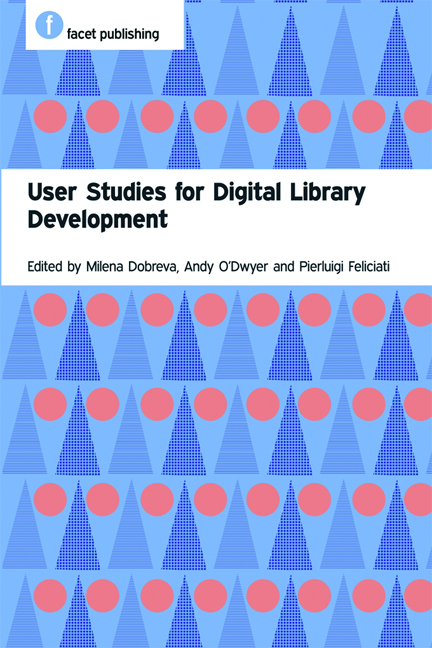Book contents
- Frontmatter
- Contents
- Preface
- Acknowledgements
- Abbreviations
- Glossary
- 1 Introduction: user studies for digital library development
- PART 1 SETTING THE SCENE
- 2 Models that inform digital library design
- 3 User-centric studies
- 4 Design issues and user needs
- 5 Users within the evaluation of digital libraries
- PART 2 METHODS EXPLAINED AND ILLUSTRATED
- PART 3 USER STUDIES IN THE DIGITAL LIBRARY UNIVERSE: WHAT ELSE NEEDS TO BE CONSIDERED?
- PART 4 USER STUDIES ACROSS THE CULTURAL HERITAGE SECTOR
- PART 5 PUTTING IT ALL TOGETHER
- Index
2 - Models that inform digital library design
from PART 1 - SETTING THE SCENE
Published online by Cambridge University Press: 08 June 2018
- Frontmatter
- Contents
- Preface
- Acknowledgements
- Abbreviations
- Glossary
- 1 Introduction: user studies for digital library development
- PART 1 SETTING THE SCENE
- 2 Models that inform digital library design
- 3 User-centric studies
- 4 Design issues and user needs
- 5 Users within the evaluation of digital libraries
- PART 2 METHODS EXPLAINED AND ILLUSTRATED
- PART 3 USER STUDIES IN THE DIGITAL LIBRARY UNIVERSE: WHAT ELSE NEEDS TO BE CONSIDERED?
- PART 4 USER STUDIES ACROSS THE CULTURAL HERITAGE SECTOR
- PART 5 PUTTING IT ALL TOGETHER
- Index
Summary
Introduction
The development of any interactive system is predicated on the understanding of user requirements that include both the context in which the system will be used and the user community who will use it. In human– computer interaction and usercentred design, design usually entails the extraction of tasks, scenarios and personas that reflect the potential and intended use (see Chapters 3 and 4). A digital library (DL), a type of interactive system, provides ‘a community of users with coherent access to a large, organized repository of information and knowledge’ (Lynch and Garcia Molina, 1995). Unlike design in other areas, the development of DLs seems to be considered an extension of the physical library and its early technologies, rather than a highly specialized application to service a particular task domain or community. As a result, DLs are often designed as generic applications, taking a onesizefitsall approach, with little variation on the functionality required from one DL to the next.
DLs evolved from an information world with a long history of examining information needs and seeking, as well as the information searching and browsing of particular user groups. This has resulted in a plethora of models and frameworks to describe and understand the information environment in which a DL will exist. In this chapter, we will examine some of that fundamental work illustrating what fits and what falls short of being pertinent to the design of DLs. At the same time, we will intertwine fundamentals from other disciplines, illustrating both the foundations and the complexity of the DL design spectrum.
In the next section, we examine briefly the types of models that have emerged in information science. The second section discusses the range of models that inform the design of a DL, not all of which are from information science. The third section examines the challenges we face with our current intellectual foundations, required to support DL design.
- Type
- Chapter
- Information
- User Studies for Digital Library Development , pp. 21 - 32Publisher: FacetPrint publication year: 2012
- 4
- Cited by



